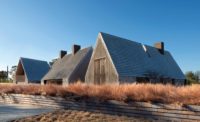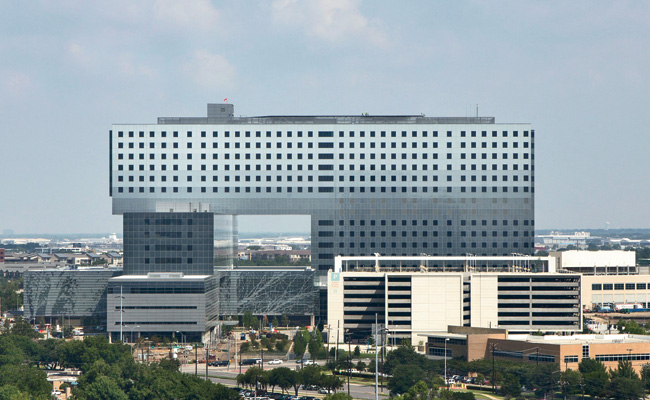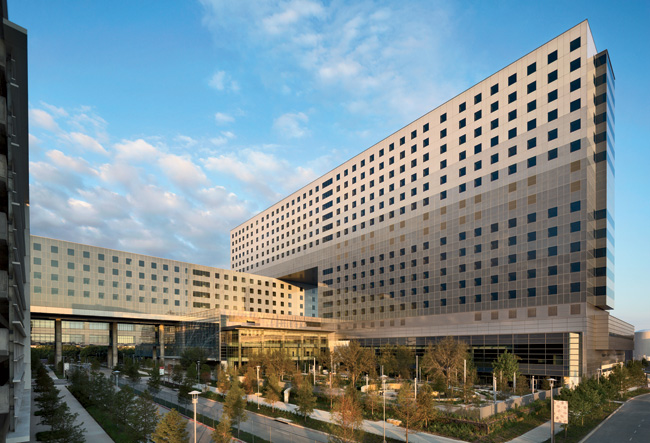New Parkland Hospital
Raising the Bar: An interplay of volumes that seem to float animates a hospital's immense scale.




























Architects & Firms
Dallas
In designing a new, 2 million-square-foot facility for Parkland Memorial Hospital in Dallas, the architect HDR + Corgan confronted significant functional and formal challenges. How do you create a monolithic facility where people don't get lost in a labyrinth of linoleum floors and fluorescent lights? How do you give a hospital a warmer, hotel-like ambience? How do you bring in plenty of daylight, and views out to an abundance of greenery? While meeting these goals is known to aid in healing, they can be hard to accomplish in a huge and complex building type.
In breaking down the scale of the 18-story, 862-bed hospital—the size of a horizontal skyscraper—the architects looked to other schemes dealing with such bulk. “We were inspired by the way Steven Holl elevated the horizontal bars at the Vanke Center in Shenzhen” (China, 2009), explains Thomas Trenolone, creative director for Parkland from HDR's Omaha office. Allusions to Holl's series of rectangular volumes floating above the ground plane are echoed in the way the new Parkland's stalwart hulk rises above a scrum of service buildings and parking lots. Perpendicular to the main mass is the elongated bar-like wing for Women & Infant's Specialty Health (WISH), raised on columns, which dynamically penetrates a five-story-high square opening in the poured-in-place concrete structure.
Visitors arriving at the hospital find a three-story glass-walled lobby, with the drop-off area framed by the WISH wing bridging the entry drive. In addition, the architects have carved out a garden in front of a ground-floor chapel and dining pavilion on the southeast, where contoured benches of Texas limestone spiral around drought-resistant planting. Elsewhere, slices of nature accent the campus, since, as Jim Henry, HDR's health-care designer in its Dallas office, says, “We wanted to put the park back into Parkland.”
The sleek glass facade, with square flush windows, pays another homage to Holl—this time to Simmons Hall at MIT (RECORD, May 2003, page 204). “Our team tried to be architecturally literate and look at other campuses and urban solutions— not just hospitals,” says Trenolone. (Who knew that Holl's controversial Simmons scheme could be tamed in Texas?)
To cut down on solar gain, HDR + Corgan sheathed the walls in low-iron glass of varying gray tints, covered with a white digitally printed pattern. The wraithlike outlines of trees and attenuated lines of donors' names (anyone who gave $10 or more to the hospital) provide a striking decorative motif. Chuck Armstrong, lead designer of Corgan, claims this is “the largest digitally printed glass building in the world.”
The monumental glazed lobby brings light and views into the entrance area, where blues and yellows on the elevators guide visitors to the various medical floors, including burn, trauma, neonatal, and medical-surgery units. A key part of planning the circulation was to separate the “backstage” functions from the “on-stage” ones: a racetrack corridor loops around the elongated floors for patients and visitors, while an inner core of elevators and shorter halls accommodates staff and equipment. In addition, glassed-in seating alcoves for families and friends are abundant, supplemented by sofas and chairs in the patient rooms (all are single-bed rooms with private baths). To keep the corridors from stretching onward monotonously, the architects angled the walls of the patient rooms where they open into the halls and, by partially glazing them, were able to allow more daylight to penetrate from the exterior windows to the interior.
The bold architectural features—the digitally printed glass, the huge punched-through void, and flush-jointed square windows—definitely make the $1.3 billion building ($690 million for construction) look much more expensive. But as Louis Saksen, senior vice president of new construction for the hospital, explains, the architects and the builders worked closely together to keep the prices down, and stayed assiduously on budget. Collaboration in any hospital project is a given, but here the design teams from HDR and Corgan worked extremely well with each other, the contractors, and the hospital. “We practically lived on-site,” says Trenolone, pointing to a group of rental retail space at the edge of the campus where the offices are temporarily located. “And we brought different things to the scheme: I had experience in urban planning, Jim in hospital design, and Chuck in airport design. There was a good alchemy among us.”
While Parkland is arguably more sedate than its architectural inspirations, it is definitely adventurous for a hospital in the United States. The new Parkland doesn't open until August, but even in its untested state, it seems worlds away from so many overwhelming and depressing health-care complexes.
People
Formal name of building:
Location:
Completion Date:
Gross square footage:
Total project cost:
Total construction cost:
Client:
Owner:
Architect:
Personnel in architect's firm who should receive special credit:
Mike Moran, AIA
Thomas J. Trenolone, AIA, LEED AP
James (Jim) Henry, AIA, EDAC
Kamran Elahi-Shirazi, NCARB
Heidi Higgason, AIA, LEED AP
Jeff Fahs, RLA
Dan Thomas, AIA, EDAC
Jim Atkinson, AIA, EDAC
Cyndi McCullough, RN, EDAC
Kevin Lynch, IIDA
Robyn Roelofs, IIDA, LEED ID+C
Bob Case, PE
CORGAN
David Lind, FAIA
Matt Mooney
Chuck Armstrong, FAIA
Tina Larsen, AIA, EDAC, LEED AP
Joe Haver, AIA, LEED AP
Lori McGilberry, CHID, IIDA, EDAC
Stewart Hempel, AIA
Architect of record:
Associate architect(s):
Interior designer:
Engineers:
Civil- Master Civil Engineering and Land Survey
Civil ' Underground Utilities, Retaining walls, Tunnel Design
Mechanical and plumbing
Medical Gas and Plumbing
Lighting
Structural
Consultant(s):
Lighting:
Acoustical:
Other:
Information Technology
Medical Equipment
Signage and Wayfinding
ADA Consulting
Civil- Site Grading/ Drainage
Civil- Site Grading/ Drainage
Code Consulting
Fire Protection and Life Safety Consulting
Building Envelope and Curtain Wall
Roof Consulting
Door Hardware Consulting
Electrical/ Low Voltage Engineering
Waterproofing Consultant
Design Bridge to Old Parkland
Design of the Parking Garage
Commissioning
IT
Medical Equipment
Signage / Wayfinding
General contractor:
Balfour Beatty
Austin Commercial
HJ Russell
Azteca Enterprise
Photographer(s):
Assassi Productions, 805.895.7703 Construction Cost: $690 million Project Cost: $1.3 billion Completion date: November 2014 |
Products
Structural system
Exterior cladding Metal Panels: Morin Metal/glass curtain wall: Glass ' Oldcastle BuildingEnvelope Rainscreen: ACM - Alpolic Moisture barrier: Tremco Curtain wall: Kawneer Other cladding unique to this project: All-Glass Fa'ade ' Pilkington Stone ' Texas Quarries Skylight - Oldcastle BuildingEnvelope
Roofing
Glazing Skylights: Oldcastle BuildingEnvelope
Other:
Doors Wood doors: Maiman Wood Doors 972-254-4201 Clay LaGrone Fire-control doors, security grilles: McKeon Door Company 631-803-3000
Hardware Closers: ASSA ABLOY Exit devices: ASSA ABLOY Pulls: ASSA ABLOY
Interior finishes
StoneTec
Acme Brick
Vermont Structural Slate
Accurate
Mechoshade
Maiman/Coveright
C/S Acrovyn
Howard McKinney, Inc.
Penco
Acoustics
Source One
ASGI
TEXTILES
Momentum
CF Stinson
Architex
Maharam
DEMOUNTABLE PARTITIONS
GLASS AND ACRYLIC PANELS
Pulp Studio
Goldray
Forms & Surfaces
Clarus Glassboards
3Form
Floor and Wall Tiles
Alys Edwards Distributed by Classic Stone Distributors
Walker Zanger
Daltile
Horizon Tile
Interceramic
Crossville
Thesize
CEILINGS
USG
Simplex
Belbien
FLOORS
Nora
Roppe
Flexco
Chilewich
Elite-xpressions
Terrazzo
EnviroGLAS
Dudick
Stonhard
Mannington Commercial
CASEWORK AND PANELING
Nevamar
Sherwin Williams
Formica
Wilsonart
Pionite
Corian
Hanstone
Caesarstone
Panel Specialists, Inc. (PSi)
Howard McKinney, Inc
McNichols Co.
Forbo Bulletin Board
WALL PROTECTION
C/S Acrovyn
SpecTrim
Lighting
Downlights:
Task lighting:
Exterior:
Dimming System or other lighting controls:
Conveyance
Plumbing
Energy |




















